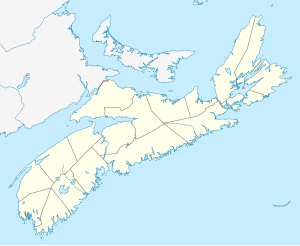Five Islands (Nova Scotia)
| Five Islands | ||
|---|---|---|
| View from the northeast of the three largest of the Five Islands: Moose Island in the foreground, Long Island and Pinnacle Island behind | ||
| Waters | Bay of Fundy | |
| Geographical location | 45 ° 23 ′ N , 64 ° 6 ′ W | |
|
|
||
| Number of islands | 5 | |
| Main island | Mosses | |
| Total land area | 1 km² | |
| Residents | uninhabited | |
The Five Islands are a group of five small islands with a total area of almost 1 km². They are located approximately 15-20 km southeast of Parrsboro in the Minas Basin , the eastern branch of the Upper Bay of Fundy , in Nova Scotia , Canada . The names of the islands are, from east to west:
- Mosses ( elk )
- Diamond ( Diamond )
- Long ( long )
- Egg ( Egg )
- Pinnacle ( needle )
The names refer to the shape of the individual islands. By far the largest island and at the same time the closest to the mainland is Moose. This island was also the only one of the Five Islands to be inhabited. According to a legend of the Mi'kmaq , the islands were created by the god Glooscap when he threw pieces of earth into water.

Geologically the Five Islands erosional remnants of basalt - ceilings that about 200 million years ago at the turn of the Triassic to Jurassic in the wake of the grave cracking arose at an early stage of the opening of the Central Atlantic. These basalts are also called North Mountain Formations and are grouped together with similarly old basaltic rocks in eastern North America, in northeastern South America and in West Africa under the name Central Atlantic Magmatic Province (CAMP). The CAMP is assigned supraregional geological importance, in that its effusion or the associated release of climate-affecting gases is made responsible for the global mass extinction at the Triassic-Jura border .
The North Mountain basalt overlays sand , silt and clay stones from the Upper Triassic ( Blomidon Formation ) and is in turn overlaid by similar sediments from the Lower Jurassic ( McCoy-Brook Formation , Hettangium - Pliensbachian ). Since basalt is more resistant to erosion than sandstone, it forms rock islands, such as the Five Islands, or promontories in the coastline. The Five Islands are the western continuation of Economy Mountain, a basalt ridge that builds up the mainland immediately east of the Five Islands. The Bloomidon and North Mountain Formations can be clearly distinguished from one another on the south side of Moose and the south flank of Economy Mountain - the light gray to rust brown basalt is located above the reddish sandstone. On the islands and the neighboring mainland to the east , the layers dip at about 10-20 ° to the north. Immediately off the north coast of the islands and on the north flank of Economy Mountain are the reddish sandstones of the McCoy Brook Formation.
The Five Islands are not permanently washed by the sea, but are located in a tidal area . In fact, the Bay of Fundy and with it the Minas Basin is the coastal region with the highest tidal range in the world. At the Five Islands it is up to 15 m, on average around 11 m. Therefore, when the tide is low, the islands are often all connected to each other and it is possible to walk to them from the mainland.
Administratively, the archipelago belongs to the Five Islands community in Colchester County .
Individual evidence
- ↑ Blair Schoene, Jean Guex, Annachiara Bartolini, Urs Schaltegger, Terrence J. Blackburn: Correlating the end-Triassic mass extinction and flood basalt volcanism at the 100 ka level. Geology. Vol. 38, No. 5, 2010, pp. 387-390, doi: 10.1130 / G30683.1 .
Web links
- Low water aerial view of four of the Five Islands from the west ( February 7, 2007 memento in the Internet Archive ) on the Nova Scotia official website. Bottom up: Egg Island, Long Island, Diamond Island, Moose Island, Mainland.
- Section at Five Islands Provincial Park. Photos, brief explanations and literature references on the geology of the Five Islands, subpage of a virtual excursion on the geology of the Fundy Rift Basin, again part of the website of a project for the multidisciplinary exploration of the supercontinent Pangea (English)
- Geological map of part of the Cobequid Highlands and the Minas Basin. Web presence of the Nova Scotia Department of Natural Resources, Geoscience & Mines Branch. Note: The Five Islands are at the bottom right of the map; Meaning of the abbreviations and colors: L T B (light gray-brown) = Blomidon formation; TJ NM (light green) = North Mountain Formation; E J M (yellow) = McCoy-Brook formation.

